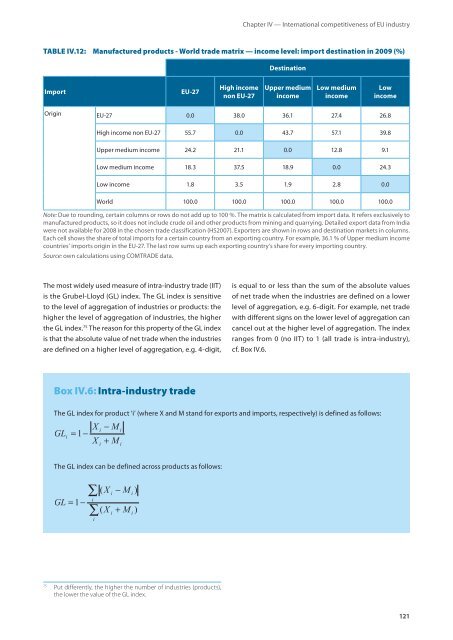EU industrial structure - EU Bookshop - Europa
EU industrial structure - EU Bookshop - Europa
EU industrial structure - EU Bookshop - Europa
Create successful ePaper yourself
Turn your PDF publications into a flip-book with our unique Google optimized e-Paper software.
Chapter IV — International competitiveness of <strong>EU</strong> industry<br />
TAbLE IV.12: Manufactured products - World trade matrix — income level: import destination in 2009 (%)<br />
import Eu‑27<br />
high income<br />
non Eu‑27<br />
destination<br />
upper medium<br />
income<br />
low medium<br />
income<br />
low<br />
income<br />
Origin <strong>EU</strong>‑27 0.0 38.0 36.1 27.4 26.8<br />
High income non <strong>EU</strong>‑27 55.7 0.0 43.7 57.1 39.8<br />
Upper medium income 24.2 21.1 0.0 12.8 9.1<br />
Low medium income 18.3 37.5 18.9 0.0 24.3<br />
Low income 1.8 3.5 1.9 2.8 0.0<br />
World 100.0 100.0 100.0 100.0 100.0<br />
Note: Due to rounding, certain columns or rows do not add up to 100 %. The matrix is calculated from import data. It refers exclusively to<br />
manufactured products, so it does not include crude oil and other products from mining and quarrying. Detailed export data from India<br />
were not available for 2008 in the chosen trade classification (HS2007). Exporters are shown in rows and destination markets in columns.<br />
Each cell shows the share of total imports for a certain country from an exporting country. For example, 36.1 % of Upper medium income<br />
countries’ imports origin in the <strong>EU</strong>‑27. The last row sums up each exporting country’s share for every importing country.<br />
Source: own calculations using COMTRADE data.<br />
The most widely used measure of intra‑industry trade (IIT)<br />
is the Grubel‑Lloyd (GL) index. The GL index is sensitive<br />
to the level of aggregation of industries or products: the<br />
higher the level of aggregation of industries, the higher<br />
the GL index. 75 The reason for this property of the GL index<br />
is that the absolute value of net trade when the industries<br />
are defined on a higher level of aggregation, e.g. 4‑digit,<br />
box IV.6: Intra-industry trade<br />
75 Put differently, the higher the number of industries (products),<br />
the lower the value of the GL index.<br />
is equal to or less than the sum of the absolute values<br />
of net trade when the industries are defined on a lower<br />
level of aggregation, e.g. 6‑digit. For example, net trade<br />
with different signs on the lower level of aggregation can<br />
cancel out at the higher level of aggregation. The index<br />
ranges from 0 (no IIT) to 1 (all trade is intra‑industry),<br />
cf. Box IV.6.<br />
The GL index for product ‘i’ (where X and M stand for exports and imports, respectively) is defined as follows:<br />
The GL index can be defined across products as follows:<br />
121
















